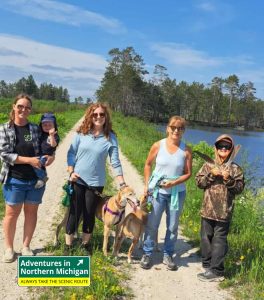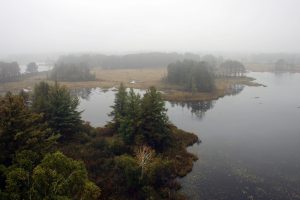Where Wilderness Comes Full Circle
Once upon a time, people tried to tame this wild stretch of Michigan’s Upper Peninsula. The land was logged, burned, drained, and plowed—all in the name of progress. But the soil was stubborn, the conditions too harsh. So the people left, and nature quietly took it all back.
What some early 20th-century entrepreneurs saw as failure, nature reclaimed as triumph. And today, that triumph is the Seney National Wildlife Refuge—a 95,000-acre sanctuary teeming with wildlife, bogs, forests, and the soft hum of nature finding its rhythm again.
Where It Is & Why It Matters
Located in east-central Upper Michigan, Seney sits between Lakes Superior and Michigan. This refuge is one of the region’s ecological crown jewels. It covers over 95,000 acres, including the 25,150-acre Seney Wilderness Area and the rare, otherworldly Strangmoor Bog National Natural Landmark.
Created in 1935, Seney National Wildlife Refuge was established to protect migratory birds and other wildlife. While that’s still central to its mission, the refuge has become so much more: a quiet haven for birders, paddlers, hikers, photographers, and anyone who just wants to unplug and breathe in the wild.
 What You Can Do Here
What You Can Do Here
You don’t have to be a hardcore birder or hiker to enjoy Seney. The refuge offers:
- 10 miles of auto tours
- 12 miles of hiking trails
- 60 miles of biking trails
- Paddling opportunities on the Manistique River
- Fishing, hunting (in season), and wildlife photography
Visit the Marshland Drive auto tour or walk the Pine Ridge Nature Trail to see trumpeter swans gliding across calm waters, or a bald eagle perched on a pine. Stop by the Visitor Center between May 15 and October 15, or explore the refuge year-round—each season brings its own magic.
A Glimpse into the Past
Seney wasn’t always a sanctuary. It was once part of the massive Greater Manistique Swamp. In the 1930s and ‘40s, workers from the Civilian Conservation Corps (CCC) and Works Progress Administration (WPA) reshaped parts of the swamp into a series of wildlife pools, with levees and control structures to encourage waterfowl breeding.
Despite those efforts, duck populations didn’t boom as hoped—but nature had its own plans. Today, those same pools provide breeding grounds for common loons, trumpeter swans, bald eagles, Canada geese, and osprey.
Other notable moments in Seney’s history include:
- 1944–45: The CCC camp briefly housed WWII conscientious objectors.
- 1947: Seney hired the U.S. Fish and Wildlife Service’s first female research biologist, Elizabeth Losey.
- 1976: A lightning strike ignited the Walsh Ditch Fire, burning 100 square miles.
- 1991: Ten trumpeter swans were reintroduced—now over 200 call the refuge home.
Strangmoor Bog: Like Nowhere Else
Within the Seney Wilderness lies the stunning Strangmoor Bog, one of the best-preserved sub-arctic patterned bogs in the lower 48 states. Glacial melt shaped this landscape into long, wavy ridges and soggy troughs, forming an ecosystem rarely found outside of Alaska or Canada. It’s a mesmerizing place, shaped more by time and ice than human hands.
The Bird Migration Superhighway
Seney isn’t just for summer visitors. It’s a vital stopover point on the Superior Birding Trail, where you might spot Northern Saw-whet Owls, Blackburnian Warblers, or American Bitterns.
And then there’s the Whitefish Point Unit, 80 miles north of the main refuge. This 53-acre parcel along Lake Superior is a globally recognized migration hotspot. Thousands of birds funnel through every spring and fall, resting here before continuing their cross-lake journey. It’s also a favorite for birders and researchers alike.
 Beyond Seney: A Refuge Network
Beyond Seney: A Refuge Network
Seney is the headquarters for a whole complex of wildlife refuges in Northern Michigan:
- Huron National Wildlife Refuge: A cluster of remote Lake Superior islands protecting seabirds.
- Harbor Island National Wildlife Refuge: A wild gem in Lake Huron with wetlands and forested bluffs.
- Michigan Islands National Wildlife Refuge: Scattered islands in Lakes Michigan and Huron, crucial to colonial nesting birds.
- Kirtland’s Warbler Wildlife Management Area: Dedicated to the recovery of the once-endangered Kirtland’s warbler.
Why It Matters—Still
Seney’s threefold purpose remains:
- Protect migratory birds and wildlife
- Provide sanctuary lands
- Conserve and restore habitats for future generations
Every trail, wetland, and pine island is managed with those goals in mind. And every visitor—whether paddling the river or peering through binoculars—gets to be part of that story.
Refuge Rules: Know before you go →




